After a dry start to February, this week’s storms have brought heavy rain and strong winds to Curbstone Valley. After the winds died down between storm cells we noticed the garden paths were strewn with tufts and clumps of various lichens that had blown from the branches above. This particular piece of lovely lacy lichen caught our eye.
This is Ramalina menziesii, commonly known as Lace Lichen, or California Spanish Moss. It hangs in gray-green lacy beards from Oaks and Firs on the property, in long branching strands, and can reach up to two meters in length.
The intricate lacy patterns of this lichen species are difficult to appreciate from a distance, but become readily apparent when viewed up close.
Lichens are typically composed of two or more organisms, a fungus, an algae, and/or cyanobacterium. Ramalina menziesii is an example of a controlled parasitic relationship between a fungus and an algae, not a moss as its common name implies.
The fungal component of this epiphytic lichen, called the mycobiont, produces the general net-like structure, the thallus, and contains and protects the photosynthetic algal component, called the photobiont.
The algal component, capable of photosynthesis, provides nutrients and energy for both itself, and the fungus.
To add to the lexicon of lichens, there are distinct structural types of lichen: foliose, crustose, fruticose, squamulose, and leprose.
For more regarding the different structural types of lichen, see a previous post by Town Mouse and Country Mouse here.
Ramalina menziesii is classified structurally as a fruticose lichen, which means the thallus has no distinct top or bottom.
Fruticose lichens may be upright, shrubby, or consist of pendulous strands, like this Ramalina species.
Ramalina menziesii primarily grows on sunny slopes that face the coast, and is usually found on oaks, conifers, shrubs, and broad-leaf trees.
In some areas of our woodland this species is particularly abundant. Ramalina menziesii can reproduce both asexually and sexually. This delicate lichen is prone to breaking easily, and fragments that break free can produce a new organism asexually.
Sexual reproduction involves the release of fungal spores, that can recombine with a new photobiont to yield a new Ramalina organism.
Lichens need sunlight, water and nutrients to grow. During harsh and dry summer conditions R. menziesii survives for extended periods of time in a dormant state, resuming growth once the rains return. As lichens obtain most of their nutrients from the air, and rainfall, they are especially sensitive to pollutants, and can serve as indicators of regional air quality.
During the dry ‘dormant’ season, pollutants accumulate on the thallus. When it rains, the accumulated pollutants are dissolved, and absorbed. As a result, in areas with high air-pollution, where pollutant accumulation is excessive in the dry season, lichens such as Ramalina can no longer survive. [1]
In southern California this lichen species was once found along the coastal plains and the foothills of the San Jacinto mountains, but now Ramalina menziesii is primarily found at elevation, above the smog layer.
We’re fortunate to reside in a less densely populated area, and the coastal breezes help to keep our air cleaner. As such Ramalina menziesii, at least for now, is fairly abundant on the property, although perhaps not as common as it once was.
Lichens have long been utilized by animals and humans. Native peoples, including the Pomo, are known to have woven fiber from Ramalina menziesii. [2] Deer and rabbits will browse on Ramalina when they can reach it, some livestock animals relish it [3], and birds will occasionally weave the strands into their nests.
In recent years The California Lichen Society has attempted to convince the California State Legislature to declare Ramalina menziesii as the State lichen. Unfortunately, thus far they have been unsuccessful, but that doesn’t stop us from appreciating this beautiful species here at Curbstone Valley.
—————–
[1] Bell, JNB, and Treshow, Michael. 2002. Air Pollution and Plant Life.
[2] Daniel E. Moerman’s Native American Ethnobotanical Database
[3] Bulletin of the California Lichen Society 9(1), 2002

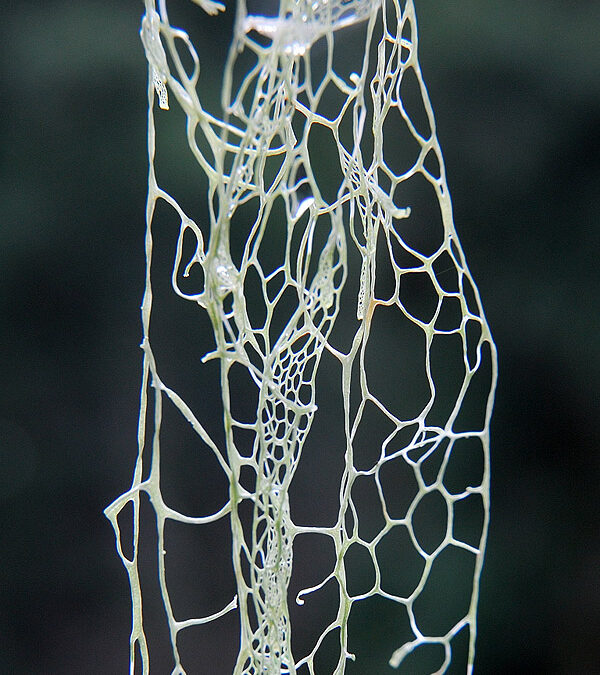
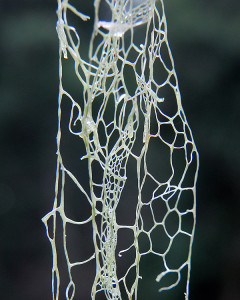

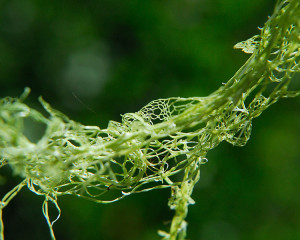
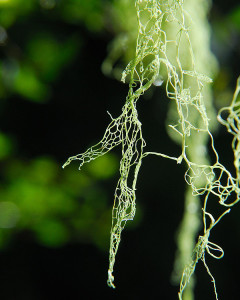
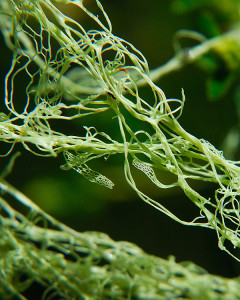
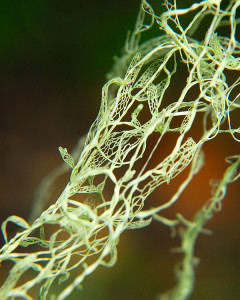

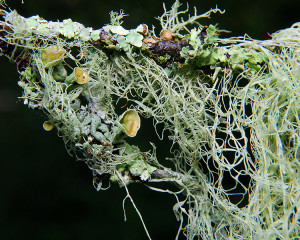

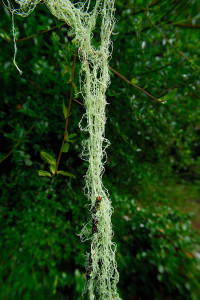
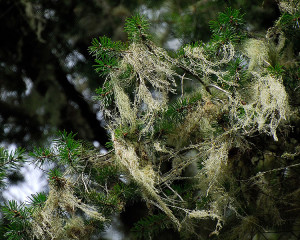
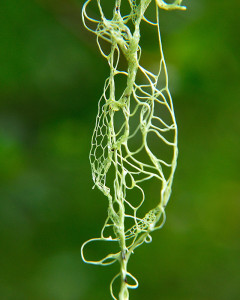
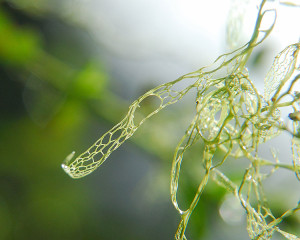

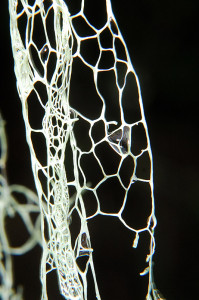
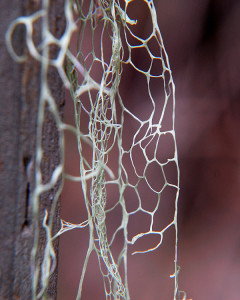
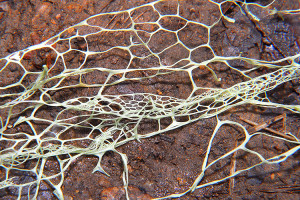







I love your photos and descriptions! You obviously put in so much research too.
Thanks Rachel. I didn’t know much about this lichen before digging around for more information. On the tree it looks rather unremarkable! 😉
Never seen anything quite like that before. Fascinating!
I had no idea that Spanish moss grew in California, probably because I’ve mostly ever been in the big cities where where air quality isn’t great. We’ve had that same wind and rain here and I had noticed lichens on the ground in our yard too, but none as unusual looking as yours.
This lichen is so lovely! On the hillside of our house in Aptos, I recall the deer stretching on their hind legs to eat it with relish – they would eat the lichen before moving on to graze on anything else…
These specimens (except the ones on the trees of course) had fallen into the gardens, inside the deer fence. I couldn’t much outside the fence, so I expect the woodland creatures snap it up quickly! Probably why I’ve never really paid attention to it before, they’ve eaten it before I’ve had a chance to look at it!
Absolutely fascinating. I was only familiar with the leaf lichen forms. I know they grow extremely slowly and was wondering how quickly this type grows.
Carolyn, my understanding is that this species grows approximately 30% of its size each year. This implies it’s probably slow to establish, but grows significantly as it ages. Of course, I’m sure much depends on weather, with the availability of rain, and how much wind there is. Quite a bit has knocked out of our trees in fragments with the recent storms.
Whoa! That is one cool lichen! I’ve never seen anything like it. Hanging in the trees, it looks so much like our ubiquitous Spanish moss, but the up-close details tell a very different story. Amazing creature!
It does look a lot like your Spanish Moss from a distance. Since I’ve lived here it’s always just looked like stringy lichen up in the trees. As I got to this specimen before our browsing wildlife this year, I finally had a chance to see how beautiful it is up close. It really is an amazing creature!
This is a beautiful lichen. I have never seen it before and your description and information was fascinating.I also never heard of a state lichen, I wonder if New York has one?
I’m not sure anyone has succeeded in designating a State lichen yet. You can’t blame the CLS for trying though, it is quite remarkable.
beautiful eerie photos.
nellie
fascinating stuff…love the photos
I’ve never seen anything quite like this before! I see a lot of lichens growing on tree bark but rarely have I seen anything hanging in such swaths as you have. It’s quite beautiful.
Dear Clare, Until I started writing my weblog I had ever seen this plant before. On mature trees and in full growth, it does look incredibly impressive. I find the mosses and lichens incredbly fascinating plants and have read with interest about how this plant survives and grows.
I followed you here from Edith’s blog
don’t you just love her..
I also like your blog..
and those lichens
wow…they do look like lace
I think I’ll look around
-suz
Clare, You are a marvel. How fascinating and your knowledge of this lace lichen is impressive. What a great canary in the mine . . . so to speak. I hope it continues to thrive on your land letting you know your air is clean. Wonderful post! Beautiful photos of this intricate and delicate fabric of fungus, algae . . . a warp and a weft of lovely lichen. I think it is beautiful in your trees too!
Well . . . not really a warp and a weft. . . lace after all!
With the first pic, I thought I had never seen it before, but when you zoomed out and showed the tree I knew exactly what you were talking about. I don’t think I’ve ever seen it up close before. I wonder if you could throw those bits that broke off back up into the trees to see if they “take root” so to speak.
Clare, all over our trees!!! and some lichen is so thick on some of the branches that I keep wanting to rub it off, but there are more trees and branches than I can possible care for.
In the event you are not aware, I wanted to mention Anna and her new online gardening magazine, Toil the Soil. Go here:
http://flowergardengirl.wordpress.com/2011/02/15/picture-yourself-in-a-gardening-magazine-at-toil-the-soil/
she is looking for articles on chickens and of course you are the first person I thought of. Would love to see you in the magazine.
I’m liking your lichen…sorry I just couldn’t resist. It is very interesting and I didn’t know much about it at all. Thanks for the post.